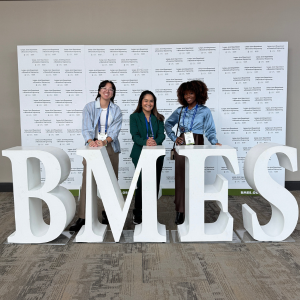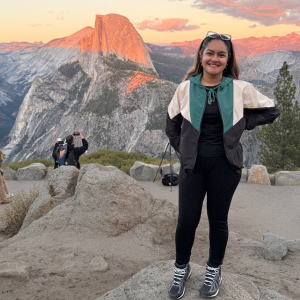|
At the 2025 Biomedical Engineering Society (BMES) Annual Meeting in San Diego, Ph.D. student Lauren A. Gomes of the University of Maryland presented her team’s research on 3D neural tissue constructs. In a poster session focused on neural engineering, Gomes discussed how engineered 3D neural environments can help model neuroplasticity, with the goal of informing future therapies for neurological disorders. In this Q&A, she reflects on her experience at BMES, shares insights from industry visits and nature excursions, and describes how the conference shaped the next steps in her academic journey.
What inspired you to pursue research in neural engineering, and how did your project on 3D neural tissue constructs come together?
The brain has always been the most interesting organ to me – it controls our emotions, hosts our memory, and contains the machinery required for thinking and learning. These very facets degrade over time due to innumerable factors – age, lifestyle habits, environment – and almost everyone we know suffers from at least some form of neural deficit. If there was a way to model the brain such that we could elucidate the mechanistic underpinnings of neuroplasticity, scientists and medical professionals alike could finally develop therapeutics that are more robust and targeted for specific neural circuit imbalances. Thus, this project came together to start the conversation on how we can develop 3D neural tissue constructs, so that we can model neuroplastic behavior in vitro to put forth more informed decisions for therapeutics and possibly implantation approaches for treating neurological disorders. The project was a collaboration with fellow Ph.D. students Kasun Pathirage, Nathaniel Renegar, and Amal Shabazz, and was advised by Professors Pamela Abshire and Timothy Horiuchi, with additional contributions from John Fisher. contains the machinery required for thinking and learning. These very facets degrade over time due to innumerable factors – age, lifestyle habits, environment – and almost everyone we know suffers from at least some form of neural deficit. If there was a way to model the brain such that we could elucidate the mechanistic underpinnings of neuroplasticity, scientists and medical professionals alike could finally develop therapeutics that are more robust and targeted for specific neural circuit imbalances. Thus, this project came together to start the conversation on how we can develop 3D neural tissue constructs, so that we can model neuroplastic behavior in vitro to put forth more informed decisions for therapeutics and possibly implantation approaches for treating neurological disorders. The project was a collaboration with fellow Ph.D. students Kasun Pathirage, Nathaniel Renegar, and Amal Shabazz, and was advised by Professors Pamela Abshire and Timothy Horiuchi, with additional contributions from John Fisher.
How was your experience presenting at BMES? Any memorable moments or feedback?
It was awesome! Memorable moments include networking with professionals in academia that work with optically recording native brain tissues, and learning about the gaps between native and in vitro synthetic tissue development.
What did you enjoy most about the conference overall—sessions, networking, or something unexpected?
What I enjoyed the most about the conference was my tour to Neurocrine – a neuroendocrinological therapeutic company that BMES sponsored a select few of us to see their development process. Seeing how the industry-side of neuroscience looks has helped me broaden my perspective on future career outlooks, as well as research opportunities for therapeutic development itself, rather than just the therapeutic platform!
 You got to explore some iconic places while out west. What was a highlight from that part of the trip? You got to explore some iconic places while out west. What was a highlight from that part of the trip?
While I thoroughly enjoyed hiking the Yosemite, Death Valley, and Joshua Tree National Parks, my favorite part of the trip was actually seeing the sea lions at La Jolla Beach! It was my first time seeing sea lions, and it was amazing to see them basking in the sun, doing flips underwater – they were clearly enjoying the beachy sun as much as we were!
What’s next for your research or academic journey?
After this experience at BMES San Diego, I’ve returned to Maryland reenergized to continue my research on developing 3D neural tissue constructs, with brand new ideas on how neuroplastic behavior can be modeled in more meaningful ways. I’ll be focusing on refining my thesis with newfound insights!
Gomes’s participation in BMES offered more than a chance to present her research. It deepened her understanding of the field and highlighted new directions for scientific and professional growth. By connecting with researchers across disciplines and visiting neuroscience-focused industry labs, she gained valuable context for the broader impact of her work. The experience affirmed the importance of collaboration, curiosity, and community in shaping meaningful research.
November 11, 2025
|

